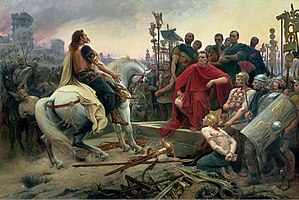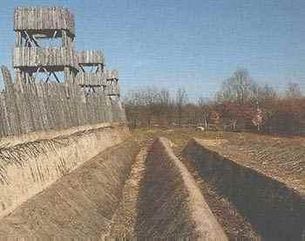Battle for Alesia
| date | September 52 BC Chr. |
|---|---|
| place | Alesia (today Alise-Sainte-Reine , Côte-d'Or ) |
| output | Victory of the Romans |
| Parties to the conflict | |
|---|---|
|
Gallic coalition |
|
| Commander | |
| Troop strength | |
|
According to Caesar: 80,000 men in Alesia; 250,000 Gaulish relief army Later estimate ( Hans Delbrück ): 20,000 in Alesia 50,000 relief army |
According to Caesar: 70,000 Later estimate: 70,000 Romans and auxiliaries |
| losses | |
|
45,000 |
7,800 |
The battle for Alesia was the decisive battle in the late summer of 52 BC. Chr. Between the Roman general Julius Caesar and the Gallic ( Celts ) under the command of Vercingetorix . The winner of the dispute was Caesar, who thereby consolidated Roman rule in Gaul for centuries.
The history
The Romans fell in 58 BC. In the southern settlement area of the Gauls. The commander of the Roman army , Gaius Iulius Caesar, had the opportunity to advance his political career through military success. The Roman military successes came very quickly and the Romans penetrated as far as Britain in the following years . Only in the year 52 BC Caesar and his troops encountered serious resistance. The Gauls, long believed subdued, united under Vercingetorix and rose against Rome. Roman merchants in Cenabum fell victim to the Gauls in the first days of the war. The insurgents threatened the Gallia Narbonensis .
Caesar, who was in Italy to administer justice, raised troops and secured the Roman province . To get to his troops stationed in winter camps, he advanced across the snow-covered Cevennes Mountains . This served him as a diversionary maneuver and he was able to concentrate his army in the Lingon area. After the first meeting of Vercingetorix's cavalry vanguard and Caesar's cavalry at Noviodunum had ended with a success for the Romans, the Arverni prince decided to take new tactical measures. With his “ scorched earth ” strategy , he tried to cut off supplies from the Romans. Twenty villages within the vicinity of Caesar's army fell victim to the flames. But the Romans proved to be extremely tough. They survived the 25-day siege of Avaricum and thereby secured the abundant supplies in this oppidum .
However, it came afterwards before Gergovia - capital of the Arverni - to a defeat for Caesar. Every seventh centurion fell. Since Julier was cut off from reinforcements from Italy, he had to order auxiliary troops from Germania at face value. When Vercingetorix gave up his successful defensive tactics and went on to attack, he suffered a bitter defeat against Caesar in the Battle of the Armançon . Thereupon he withdrew with his troops to Alesia.
The battle
Caesar pursued the fleeing Vercingetorix and locked him up in Alesia by extensive siege works . Vercingetorix commanded about 20,000 and Caesar about 70,000 soldiers. However, Vercingetorix succeeded in sending his cavalry away before the enclosure, as they would have unnecessarily strained the supplies during a siege. The riders were also given the task of calling the Gallic tribes to form a relief army .
Caesar himself quickly became besieged, as he was now also surrounded by the advancing Gallic relief army (around 50,000). With extensive fortification work , Caesar erected a 16 km long inner siege ring ( circumvallation ) and a second, 21 km long, outwardly directed defensive ring ( contravallation ) to defend himself against these enemies. These entrenchments contained towers, traps, trenches, ramparts, footbars and barriers against cavalry attacks.
Already after about thirty days the food in Alesia was running low. Vercingetorix sent all those unable to fight (old people, women, children) from the city because they could no longer be fed. In De Bello Gallico , Caesar bluntly reports his decision not to let civilians go through his lines, so that they died slowly and painfully in front of everyone.
The arrival of the Gallic relief army at Alesia and the subsequent attack was the signal for Vercingetorix to attempt an escape. Through determined advances and clever organization of the troops, Caesar and his deputy Titus Labienus succeeded in that "battle on two fronts" both in repelling attempts to break out of Alesia and in keeping the outer Gaulish army away. After Caesar's Germanic horsemen had dispersed the relief army, it gathered again and attacked a weak point in the outer fortification. This was caused by the rocky flank of a hill on which part of the outer Roman siege line had been pulled through, but could not be completely closed due to natural obstacles.
The Gallic armies broke through the fortifications and attacked the Roman troops from the front and behind. Caesar motivated the Roman legions by appearing on the battlefield, took four cohorts and led them into battle. At the same time, he ordered some cohorts to circumvent the battlefield extensively. When the Roman troops fell in the rear of the Gaulish armies, they fled, but were persecuted by the Romans for a while. Vercingetorix withdrew to Alesia after receiving news of this. A little later he surrendered in the hope that Caesar would not sell him and his people into slavery.
Six years later, when Caesar returned to Rome to celebrate his victories in Gaul, Egypt, Asia Minor and Africa in a triumphal procession , Vercingetorix, who had been in prison until then, was dragged through Rome in chains and then, on Caesar's orders, in the Tullianum strangled.
Later estimates
Beginning in the 1860s with Emperor Napoleon III. , a nephew of Napoleon I , was doubted about Caesar's description of the battle. Terrain, line-up and course of the battle speak for armies of equal strength, in no way for a numerical superiority of the Gauls. In particular, the flank march with bypassing would not have been possible against a numerically superior enemy. Also, with Caesar's numbers and the terrain, the Gauls' order of battle must have been over 100 men deep, which would have been a military absurdity. It is not an isolated case. Caesar had a general tendency to exaggerate the strength of opposing troops.
Alesia in popular culture
The Gallic resistance under Vercingetorix, which ended in the defeat at Alesia, became a national myth in France, especially in the 19th century , comparable to the heroization of Arminius in Germany.
In today's popular culture, the battle for Alesia is mentioned in the following works:
- Multiple mentions in the Asterix comic series (Majestix: "Alesia? I don't know Alesia!" In: Asterix and the Arvernerschild )
- Colleen McCullough's novel : Rubicon from 1997.
- 2001 film Vercingétorix with Christopher Lambert .
- Music CD by the band Ex Deo with the title Romulus (2009) with several songs, for example Storm the Gates of Alesia and Legio XII .
- The two-part television film Julius Caesar treats the battle as a major success for Caesar.
- Music CD by the band Eluveitie with the title Helvetios with the song Alesia
- The television series Rome (2005-2007) begins with the final phase of the siege of Alesia and the surrender of Vercingetorix
- Norman Spinrad : The Druid King. (Roman), Blanvalet, Goldmann, Munich 2003, ISBN 3-442-24222-3 .
- Dietrich Oldenburg : No closed season for wolves (novel) Haag and Herchen, Frankfurt 2004, ISBN 3-89846-268-4 .
literature
- Christian Goudineau: Caesar and Vercingetorix. von Zabern, Mainz 2000, ISBN 3-8053-2629-7 .
- Yann Le Bohec : Alésia. Fin août – début octobre de 52 avant J.-C. Tallandier, Paris 2012, ISBN 978-2-84734-844-6 .
- Michel Reddé : Alesia. From national myth to archeology. Translated from the French by Andrej and Auguste Miron. von Zabern, Mainz 2006, ISBN 3-8053-3531-8 .
- Michel Reddé, Siegmar von Schnurbein (ed.): Alésia et la bataille du Teutoburg. Un parallèle critique des sources (= Francia . Research on Western European history. Supplements. Volume 88). Thorbecke, Ostfildern 2008, ISBN 978-3-7995-7461-7 .
- Jean-Paul Savignac: Alésia. Différence, Paris 2012, ISBN 978-2-7291-1971-3 .
- Jean-Louis Voisin: Alésia. Un village, une bataille, un site. Bourgogne, Messigny-et-Ventoux 2012, ISBN 978-2-902650-29-3 .
Web links
- The Battle of Alesia - relevant details from the historical original “De bello Gallico” by Caesar, with sketches and drawings
- Caesar's fortifications in front of Alesia ( Memento from August 20, 2013 in the Internet Archive ) (reconstruction)
- Alesia. Caesar's siege as a work of art.
- MuséoParc Alésia , official website of the local museum
- Sphinx: The Last Battle of the Celts - The Great Slaughter - Celts as victims of Caesar's art of war
- Sphinx: The Last Battle of the Celts - King Vercingetorix 'tactics
- Sphinx: The last battle of the Celts - attack on the protective wall - Roman technology against Celtic superiority
- Sphinx: The Last Battle of the Celts - The Death Strip of Alesia - An almost perfect system of deterrence
Individual evidence
- ↑ Hans Delbrück : History of the art of war in the context of political history. Volume 1: Antiquity. 7. Book, Chapter 5. Available online
Coordinates: 47 ° 32 ′ 14 ″ N , 4 ° 30 ′ 1 ″ E




